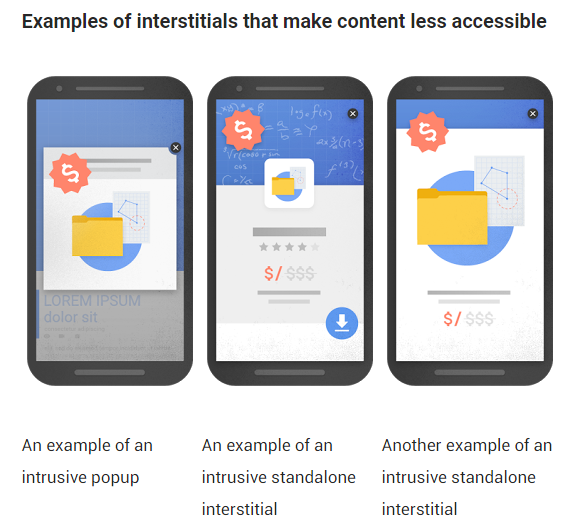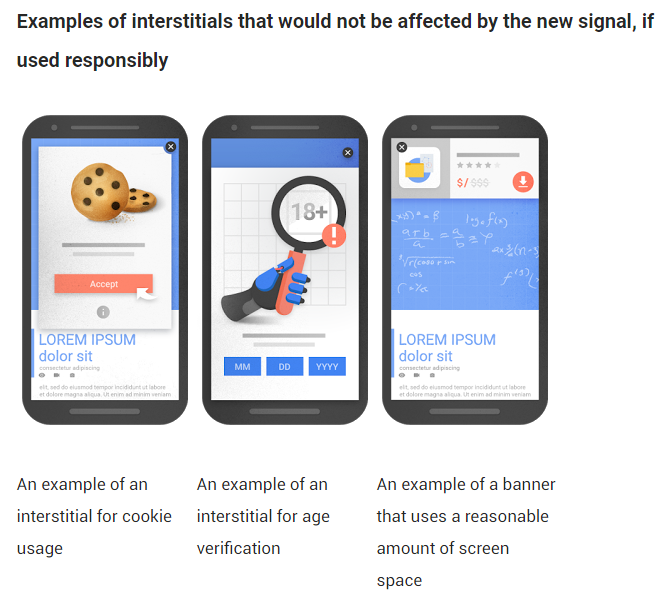Google Penalty for Pop-Ups is on the Way

August 23, 2016
Think back to the last time you were reading an intriguing article on the web. The headline piqued your interest, you clicked through to the article and then quickly became engrossed in reading the information. Suddenly, your reading is interrupted by pop-ups that cover the screen. Your attention has been diverted and your focus shuttered.
Annoying, right?
If pop-ups consistently encroach upon your experience on the web, don’t worry – hope is on the horizon!
According to the Google Webmaster Central Blog, starting January 10th, 2017, pages with these intrusive pop-ups, also called interstitial ads or interstitials, may find themselves not ranking as highly in mobile search results.
The Journey to Mobile-Friendly Search Results
Google has made it clear over the past several years – the user matters. You have to provide a great, relevant user experience, or forget it.
Google is a business too and every time your website appears in the SERPs (search engine results pages), that’s a business referral from Google to their user. You have to be an authoritative, relevant source, otherwise, that referral is useless and credibility takes a hit on both sides.
You don’t get to be the search engine with the biggest share of internet searches unless you build a reputation for providing the right results with the right answers to your searchers’ needs.
In the past couple of years, Google has put the pressure on sites to become mobile-friendly and offer a great experience to mobile users.
Back in 2014, they added a mobile-friendly label to help users easily identify which results are mobile-friendly.
After years of suggesting websites become responsive and mobile-friendly, Google finally started putting their foot down April 21st, 2015 with what many in the web-world began calling “Mobilegeddon.” The message was clear – get mobile-friendly or else.
The focus first shifted to pop-ups in November 2015 with an app interstitial penalty. It was rolled out as part of the mobile-friendly algorithm (a.k.a. what rolled out during Mobilegeddon). This update specifically targeted pages with those annoying app install interstitials that took over the entire page.
According to Google, “pages with an app install interstitial that hide a significant amount of content on the transition from the search result page won’t be considered mobile-friendly.”
As was already established with the launch of the mobile-friendly algorithm, if you’re not considered mobile-friendly, you can say goodbye to showing up in the mobile search results.
Now, we’re in 2016 and the mobile-friendly labels have been removed to declutter the mobile search results. With 85% of pages in the mobile search results meeting the basic mobile-friendly criteria, the label has become irrelevant. Though the labels have been removed, Google stresses that the mobile criteria will continue to be a ranking signal.
Looking towards 2017, the future of pop-ups does not look good. The update coming in January will focus on all interstitials that cover a large portion of the main content of the page, instead of just full-page app install interstitials.
However, not all is lost and not every single interstitial will be affected by the new signal, like those required to verify a user’s age, or accept cookies.
Let’s take a closer look at what’s to come.
Details For Upcoming Pop-Ups Penalty
The focus of this update is all about helping users find the content they’re looking for without obstructing them. Intrusive interstitials keep the user from seeing the content they clicked through to see – it doesn’t matter whether or not that interstitial increased the conversion rate on your newsletter signup or eBook download, it hinders your user’s experience.
Your users are frustrated by your annoying pop-ups, especially on mobile, and Google is taking notice.
Disruptive Interstitials You Should Stop Using
According to the Webmaster Central Blog, these are the types of techniques that make content less accessible to the user and will be targeted by the update:
- “Showing a popup that covers the main content, either immediately after the user navigates to a page from the search results, or while they are looking through the page.
- Displaying a standalone interstitial that the user has to dismiss before accessing the main content.
- Using a layout where the above-the-fold portion of the page appears similar to a standalone interstitial, but the original content has been inlined underneath the fold.”
Below is a visual from Google illustrating the types of interstitials that are considered disruptive and make content less accessible (so you should stop using them!):

Interstitials Not Affected (If Used Responsibly)
Not all interstitials will be affected by this update as some are legally required or are used in a way where the main content is not affected.
The Webmaster Central Blog lists the techniques that would not be affected by the new signal (if used responsibly):
- “Interstitials that appear to be in response to a legal obligation, such as for cookie usage or for age verification.
- Login dialogs on sites where content is not publicly indexable. For example, this would include private content such as email or unindexable content that is behind a paywall.
- Banners that use a reasonable amount of screen space and are easily dismissible. For example, the app install banners provided by Safari and Chrome are examples of banners that use a reasonable amount of screen space.”
Don’t worry, Google provides an illustration depicting examples of these acceptable interstitials as well:

What to do Moving Forward
First things first, check yourself. If you’re using interstitials on your site, make sure they make the cut as soon as possible.
Put the lead generation and conversion optimization mindset to the side for a second and be brutally honest about whether or not this interstitial makes content less accessible to your users.
If it falls in the disruptive category, get rid of it or change it to be a small banner across the top or bottom of the page.
If you absolutely must engage with pop-ups moving forward, let your users view the content they clicked through to see and hit them with a pop-up only when they show exit intent. When used responsibly and effectively, this is a method to re-engage the user in a helpful manner as they are about to exit your site.
Whatever you do moving forward, make sure your focus is on the user and their experience on your site.
Is your site providing an unfriendly experience to your mobile users?
Let the VIG team help get you back on track!


